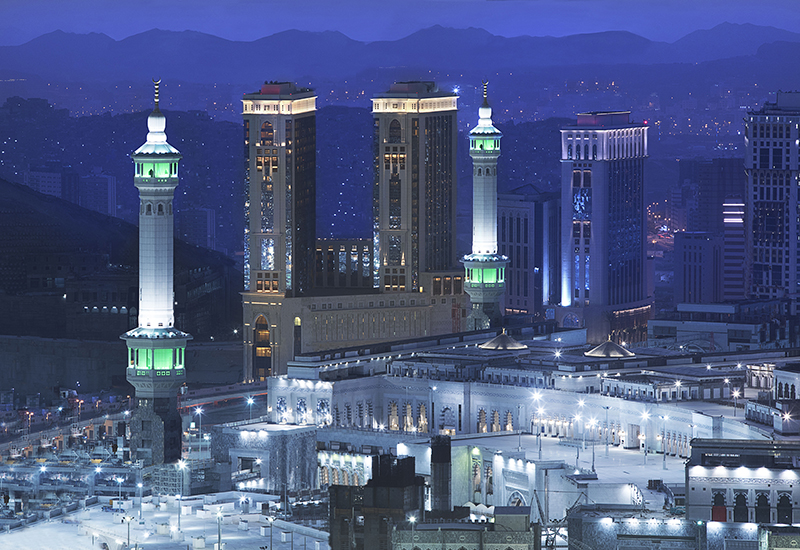With over 50,000 existing rooms and another 35,000 more in the pipeline, the Makkah and Madinah markets remain an important segment for hotel operators, with some entering the competitive market for the first time this year.
The investment is bolstered by Saudi Vision 2030, which aims to boost domestic tourism. Vision 2030 targets include plans to attract 3.75 million Hajj pilgrims by 2020 and 6.7 million by 2030, while growing Umrah pilgrims to 15 million by 2020 and 30 million by 2030.
Today, Makkah and Madinah record on average 20-25 flights a day, and the number triples during the Hajj season.
Emaar Hospitality Group CEO Olivier Harnisch notes: “Saudi Vision 2030 outlines the important role the hospitality sector plays in promoting tourism and diversifying non-oil revenues. Increasing pilgrim numbers will provide significant opportunities for expanding hotel room supply and the hospitality market will benefit from the surge in demand.”
Emaar Hospitality is set to enter the Makkah market for the first time in 2019 with the opening of its flagship 1,490-room Jabal Omar Address Makkah.
In 2017, the Kingdom reported 2.35 million Hajj pilgrim arrivals, up 26% (or 1.8 million) from 2016. The number of foreign Umrah pilgrims was reported at 6.75 million (as of June 2017), up 5.6% from 6.39 million during the same period in 2016, according to TRI consulting.
Occupancy increased marginally across Makkah. However, the increase in supply saw ADRs fall from US$245 in 2016 to $229 in 2017, causing a 4% decline in RevPAR. In Madinah, four- and five-star branded hotels saw occupancies improve marginally from 61.8% in 2016 to 62.0% in 2017. However, a 6.4% drop in the ADR from US$208 to $194.4 during the period resulted in lower RevPAR – down 6.2% year-on-year – and caused a 3.8% decline in GOPPAR during the year.
2018 has been particularly tough for hotels in Makkah. According to STR, year-to-date as of April 2018, Makkah’s RevPAR is down 20%, and Madinah’s down 8%, owing in large part due to the $26 billion expansion of the Grand Mosque and the subsequent restriction of visas due to the ongoing work. This led to more competitive pricing by hotels to try and increase market share to compensate for occupancy declines and increased competition.
These challenges, however, are not restricting operators’ expansion plans for this market. With over 14,000 rooms and 31 hotels, the InterContinental Hotels Group is the largest international operator in Saudi Arabia. IHG vice president operations Middle East Bastien Blanc says: “We are continuously looking to open more quality hotels to cater to the ever-growing number of pilgrims undertaking Hajj and Umrah each year. We understand the market and have a dedicated team who have the intimate knowledge of specific understanding of the location to meet the unique and individual requirements of pilgrims.”
Makkah’s diversification
While the Makkah and Madinah markets have traditionally leaned toward luxury offerings, recent trends reports show visitors are expecting more diversified choices.
Blanc notes: “In a market traditionally dominated by luxury and upscale hotels, we are seeing more and more interest in mainstream brands; our Holiday Inn brand is well suited to this demand.”
Research by STR also notes more diversification in the classes of hotels coming into the market, with more mid-range hotels being built.
There is also growing demand for extended stay accommodation. Harnisch says: “Makkah today has one of the fastest supply growth rates in the Kingdom, especially in branded residences, meeting the demand for guests looking for unique personalised experiences.”
According to TRI director Rashid Aboobacker, visitor demographics in Makkah and Madinah are changing — a shift that is likely to have a “profound impact” on the markets.
He explains: “Empirical evidences suggest that the visitor demographics may be slowly be changing as more youth are beginning to travel to Makkah and Madinah for pilgrimage, both from within and outside the region. This may be due to a combination of factors; including the increased availability of visas, growing accessibility and connectivity, and or other cultural and behavioural changes. This shift is likely to have profound impact on the hospitality markets in Makkah and Madinah in the medium- to long-term as hotels will need to adapt their offerings to new types of customers, such as millennials, in the future.”

| Advertisement |









 Search our database of more than 2,700 industry companies
Search our database of more than 2,700 industry companies









